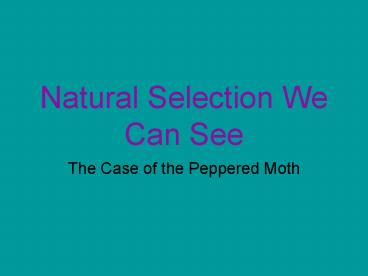Natural Selection We Can See - PowerPoint PPT Presentation
1 / 18
Title:
Natural Selection We Can See
Description:
... lived on trees covered by silvery lichen. ... Silvery lichen was still on trees in the rural areas. Case of the Peppered ... shows a tree with silvery lichen. ... – PowerPoint PPT presentation
Number of Views:49
Avg rating:3.0/5.0
Title: Natural Selection We Can See
1
Natural Selection We Can See
- The Case of the Peppered Moth
2
- Species become endangered when the population is
decreased to the point that a stress can affect
survival. - Stresses may be natural or human-made.
- Human causes are listed on the next slide.
3
H abitat loss I ntroduced Species P ollution P
opulation Growth O ver consumption
4
Case of the Peppered Moth
- Peppered moths are a common moth in England.
- There are variations in the coloration of
peppered moths from silvery white with gray
speckles to dark gray/black. - The most common form before 1850 was a mixture of
white and black called peppered. About 90 of
the moths found in nature were peppered.
5
Case of the Peppered Moth
- There are two alleles for the color of silvery
moths B for black and b for white. The black
color is melanin. - In the laboratory, the moths occur in a ratio of
1 black2 peppered 1 white. - BB black, bb white, and Bb peppered.
- The black is the dominant allele causing
speckling when present.
6
Case of the Peppered Moth
7
Case of the Peppered Moth
- Peppered moths lived on trees covered by silvery
lichen. - During the Industrial Revolution, carbon-fuel
pollution killed the silvery lichen on urban
trees. - Coal soot coated tree trunks causing the trunks
to become darker.
8
Case of the Peppered Moth
- In urban industrial areas, silvery-white peppered
moths became less common and the dark gray/black
moths became more common. - In rural forest regions, the silvery-white
peppered moth remained the most common type. - Silvery lichen was still on trees in the rural
areas.
9
Case of the Peppered Moth
- Hypothesis
- Moths that have a camouflage advantage will
survive and become the most common color type. - Control natural condition of trees with
silvery lichen - Variable carbon soot
10
Case of the Peppered Moth
- The next slide shows a tree with silvery lichen.
- Try to find the dark gray peppered moth in the
next slide.
11
Case of the Peppered Moth
- Procedure
- Release the same number of black, peppered,
and white moths in - an industrial area where the tree trunks are
dark and a natural area where the tree trunks
have silvery lichen. - 2. Capture and count the surviving moths.
- 3. Compare the populations.
12
(No Transcript)
13
(No Transcript)
14
Case of the Peppered Moth
- Try to find the silvery-white colored peppered
moth in the next slide.
15
(No Transcript)
16
(No Transcript)
17
Case of the Peppered Moth
- What advantage does camouflage provide the moth?
- Why might the dark-gray variation of peppered
moth have an advantage in urban areas where tree
trunks were darkened by coal soot?
18
Case of the Peppered Moth
Today, about 90 of the population is light
colored. Why did the population shift back to
pre-Industrial Revolution composition?































